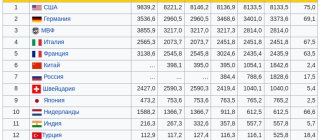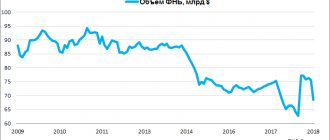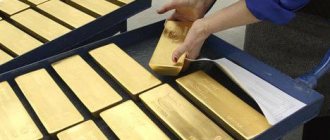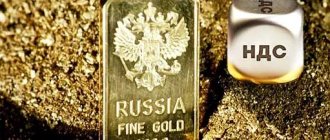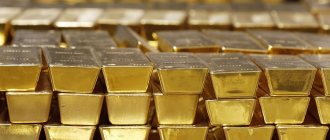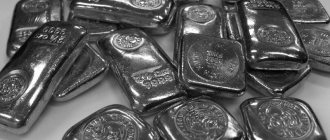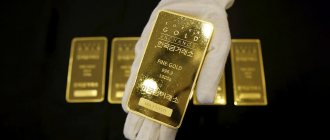What is the gold and foreign exchange reserve
It is worth distinguishing between gold reserves and gold and foreign exchange reserves - these are different concepts.
The gold and foreign exchange reserve is a reserve of monetary gold, funds in foreign currency (cash, deposits, correspondent accounts, unallocated metal accounts, debt securities), special drawing rights, and a reserve position in the IMF (International Monetary Fund). All this is under the control of government monetary authorities.
Gold and foreign exchange reserves, by their economic essence, are assets of an individual country (state), and assets that have high liquidity (most often they are called highly liquid).
How gold and foreign currency reserves are created
One of the ways to create gold reserves, which are part of gold and foreign exchange reserves, is to cast gold bars after its preliminary refining, that is, a set of measures to deeply clean the metal from impurities. All processes for organizing the formation of the Russian reserve of gold and currency in 2018 are led by Gokhran, a government agency under the Ministry of Finance.
Why is a reserve formed?
The purpose of creating and maintaining gold and foreign exchange reserves of the Russian Federation, like any other country, is to pay debts with foreign countries and other state budget deficits or generate income to cover the budget deficit.
Airbag storage
Gold bars, coins and cash require special storage facilities. There are about 600 such equipped premises in Russia at regional branches of the Central Bank of Russia. According to official reports, most of the gold and currency reserves are located in the Moscow Central Repository of the Central Bank of the Russian Federation, almost a third - in St. Petersburg and Yekaterinburg. Almost a third of the gold and foreign exchange reserves, 109 billion, are placed in US debt obligations.
This is an international practice: financiers of China, Germany, England, and France keep their countries’ gold and foreign exchange reserves (in whole or in part) in America. For many years, the United States has been telling the world that the most reliable currency is the dollar. However, now this statement raises many doubts.
The concern stems from the growing national debt and the fact that the expenditure side of the American budget is significantly larger than the revenue side. The state, living beyond its means, is building something like a financial pyramid. In a situation similar to the 1971 default, the situation may well repeat itself when the States simply refused to pay their bills.
In assessing such investments, Russian economists have formed two diametrically opposed positions. According to M. Delyagin and A. Razuvaev, by placing part of gold and foreign currency reserves in US debt obligations, the financial block of the Russian Government made a serious mistake. But N. Krichevsky believes that such a problem simply does not exist, it was invented and the Government’s decision is correct.
Composition of the gold and foreign exchange reserves in Russia in 2021
Russia's gold and foreign exchange reserves today (2020 data) include the following reserves (that is, funds reserved or available for use):
- Foreign currency reserves.
- Money in correspondent accounts.
- The totality of deposits made in gold with a deposit period of up to 12 months.
- Gold (namely gold bullion reserves).
- Non-resident debt securities. In this case, the rating of such securities must not be lower than “AA-”.
The bulk of Russia's modern gold and foreign exchange reserves in 2020 (about ninety percent) are in euros and dollars; gold itself currently accounts for only 9% of gold and foreign exchange reserves in Russia.
Ingots of society
Currently, the Central Bank reserves contain 1,944 tons of the yellow metal. The regulator has been steadily purchasing at an increasing pace since 2008 (then reserves were less than 500 tons). At the same time, the share of the precious metal in the structure of Russia’s international reserves is growing: over ten years it has increased from 2.5 percent to 17 percent.
Gold reserves in Russia reached their maximum in 1941 - 2800 tons. “At that time, currency unions appeared and collapsed very quickly, and gold seemed to be a reliable alternative way to store gold and foreign exchange reserves,” recalls Otkritie Broker analyst Timur Nigmatullin. Now gold has not lost its relevance.
In the USSR, replenishment of supplies was carried out through mining, confiscation from the population and sale of goods through special Torgsin stores (an organization through which in 1931-1936 foreigners and Soviet citizens exchanged valuables - precious metals, stones, antiquities, cash currency - for products and other goods). Today, the Central Bank can only buy gold from banks with a license to work with precious metals or through the Moscow Exchange and uses reserves for other purposes.
The yellow metal is almost not subject to depreciation, unlike money (that is, it allows you to compensate for the devaluation of currencies in reserves), and also helps to diversify the reserve portfolio itself. In addition, gold is a universal means of payment that can be used as collateral for the issuance of other derivative instruments (for example, it can be pledged to another country when opening a line of credit under the gold swap procedure).
Updating the record for gold reserves will take Russia from fifth to third place after the United States and Germany
True, all these procedures are not the most convenient, and they are resorted to in the event of a deep economic crisis, as is currently happening in Venezuela (the country is gradually selling its gold reserves for foreign currency). Russia uses gold exclusively as a means of protecting and diversifying investments. In light of recent events - the April package of American sanctions - the Bank of Russia has reduced investments in US government bonds by six times, reducing the share of dollar assets in reserves in favor of gold.
It is impossible to completely abandon dollar assets, since the Central Bank’s reserves must reflect the structure of trade relations, Timur Nigmatullin emphasizes. He believes that interest in gold will decline due to the high cost of storage and transportation.
At the same time, nothing prevents the Bank of Russia from continuing to increase its gold reserves: RG’s interlocutor believes that in 10-15 years Russia will reach its historical maximum (in the inertial scenario), which means it will be able to move from fifth to third place after the United States and Germany's monetary gold reserves. The Central Bank does not receive direct profit from the precious metal, but given that last week world gold prices fell to a yearly minimum of $1,212 per troy ounce (31.1 grams), a pleasant bonus in the future is not excluded.
The worse the news in the world, the more reasons for gold prices to rise
The dynamics of gold prices last week and the generally protracted downward trend (since the spring of this year) are explained by the strengthening of the dollar in the foreign exchange market, explains BCS Premier financial analyst Alexander Bakhtin. Among the reasons for the fall in prices, he also names the low level of inflation in the United States and the lack of interest in gold on the part of large investors. The latter was facilitated by a general decline in global geopolitical risks after the historic meetings of US President Donald Trump with North Korean leader Kim Jong-un in June and with Russian President Vladimir Putin on July 16.
“But in general, there is an understanding on the market that there are no obvious drivers for the rise in the value of the precious metal, except for serious geopolitical or financial force majeure that could cause a global flight from risks,” says Alexander Bakhtin. When forecasting the price of gold, he also pays attention to expectations of a rate hike by the US Federal Reserve, as well as the development of the trade conflict between the US and China. Typically, the worse the news, the higher the risks and the more likely the precious metal is to rise. “The price range for gold until the end of this year, other things being equal, according to our estimates, will be $1,200-1,260 per troy ounce,” the analyst concludes.
Dynamics of Russia's gold reserves over a century (1913 - 2020)
Russian gold - foreign exchange reserve from 1913 to 2021 changed as follows:
- In pre-revolutionary Russia in 1913, the value of the gold metal reserve was 1,338 thousand tons. Until the end of the summer of next year, a gold standard operated in Russia, that is, a monetary system in which gold was the reference unit for any calculations. Each ruble monetary unit corresponded to 0.78 grams of gold.
- At the initial stages of the 1st World War in Russia, gold and foreign exchange reserves had the following structure: 1,695,000,000 rubles or 1,311 tons of gold and more than sixty billion dollars. Russian reserves were significantly reduced after being sent to England. The rest of the reserves were in Petrograd, later they were mostly transported to Nizhny Novgorod and Kazan, and before the revolution - to Finland.
- In 1918, after the signing of the Brest-Litovsk Treaty in the USSR, 250 tons of valuable metal were moved to Germany.
- In 1920, the value of Russia's gold and foreign exchange reserves decreased by almost twelve tons of gold (15 million Russian rubles) due to shipment to Estonia; four million in gold - due to payment to Latvia; by five million - due to payments to Turkey; by 200 tons of gold - due to the acquisition of English and Swedish locomotives.
- Reserves reached their historical peak under Stalin. In 1941, they increased to 2,800 tons of gold; after 12 years, the reserves amounted to 2,500 tons.
- Further dynamics look like this: 1993 - 4; 2000 - 12; 2005 - 124; 2007 - 303; 2008 - 478; 2014 - 496.7; in 2021 - 377: as of March 1, 2018 - 453,644 billion American dollars (USA).
Investment
The Central Bank of Russia, investing funds from the reserve, selects financial instruments with high reliability and government guarantees. In this case, the income from the operation will be less, but the liquidity and safety of the invested funds will be guaranteed. The credit ratings of the reliability of issuers are carefully monitored, which are regularly compiled by the world's leading rating agencies - Standard & Poors, Fitch, Moody's
To minimize risks, the principle of diversification is widely used. In this case, the money is distributed “in different baskets” and invested in convertible currencies:
- American dollars;
- pounds;
- Euro;
- Swiss francs;
- Chinese Yuan;
- Japanese yen.
Controversy continues around the issue of methods for managing gold and foreign exchange reserves. Financial elites disagree on the main thing: whether gold and foreign currency reserves should work. On the one hand, by investing in various projects, revenues to the state treasury can be increased at the expense of profits. On the other hand, reserve money guarantees certain funds in case of a crisis or other extreme situation.
Information about gold and foreign exchange reserves published in the press cannot be called absolutely accurate. In any country in the world, this information is classified as state secrets. However, the World Gold Council said that Russia has almost doubled its gold reserves in five years.
What will happen if Russia's reserves are greatly reduced?
If the RF stock size decreases quickly and/or significantly:
- the national currency of Russia will not have the necessary support;
- citizens' trust in the state's monetary policy will be lost;
- the country's international rating will decrease;
- The Russian Federation will no longer be able to repay its external debt obligations;
- there will be a risk of being unable to provide support for the state and its citizens in the event of a national disaster;
- Russia's economic independence will be in question.
Despite all the above facts, it is not recommended to increase the share of gold in gold and foreign currency reserves, since this precious metal falls in price, therefore, becomes less liquid when compared with reserves in foreign currency, and also does not generate interest income.
Countries with the largest gold reserves
In 2021, Russia bought 274 tons of gold for its reserves
. This is quite a lot - during that year, all the central banks of the world bought 651 tons of precious metal. Interestingly, this was even before the events of 2020, when gold broke the historical price record - that is, several countries were able to make good money on the growth of the global market.
In general, the last few years before the crisis were quite successful for the global economy - despite trade wars and other conflicts. According to World Bank data, China, Japan and Switzerland are ahead of all countries.
but Russia is also among the leaders:
Interestingly, Norway's oil fund
has assets of approximately $1.3 trillion - but this is a pension fund, and it is intended to pay pensions when the country faces financial problems, so it is not included in the gold and foreign reserves (otherwise Norway would have taken third place in the ranking).
Russia leads the ranking among all post-Soviet countries, other states are lower:
- Kazakhstan – 49th place ($30.9 billion);
- Uzbekistan – 52nd place ($27.1 billion);
- Ukraine – 57th place ($20.8 billion);
- Belarus – 83rd place ($7.2 billion);
- Azerbaijan – 85th place ($6.7 billion), etc.
As you can understand, the volume of gold and foreign exchange reserves does not always correlate with the standard of living in the country. For example, Mexico's gold reserves are higher than those of Great Britain, and Libya (where the civil war continues) is higher than Sweden and Norway. In the post-Soviet space, not everything is obvious either: Ukraine’s gold reserves are several times higher than those of the much more prosperous Baltic countries. And one of the most successful republics, Estonia, has only $755 million, which is less than Tajikistan, Kyrgyzstan or Georgia.
Thus, gold and foreign exchange reserves are not always the key to economic success
. And the experience of the listed countries confirms this - even in Russia, which is among the top ten countries in terms of reserves, there are so many socio-economic problems within the country that it is simply impossible to compare the standard of living with Hong Kong or South Korea.
On the other hand, a higher level of gold reserves allows you to look into the future with greater confidence. This reduces the likelihood of default or devaluation of the national currency, and if another global financial crisis occurs, pensioners will not be left without a livelihood.
In what cases will gold reserves be used?
The wealth of a country is judged by the amount of gold reserves. Gold is not used directly in calculations. It is needed for an emergency purchase of currency or obtaining a secured loan. Of all gold and currency reserves, currencies and securities are most often used. Gold is simply accumulated in vaults and serves as a guarantee of state stability. Gold will be used only in an emergency when there is no access to other reserves, or it will be very unprofitable to use them. The role of the gold reserve remains unchanged. It consists of leading the country out of crisis and saving the state and citizens in emergency situations.
Author of the article, financial expert
Dmitry Tachkov
Hello, I am the author of this article. I have a higher education. Qualified investor. Finance and credit specialist. Worked in commercial banks of the Russian Federation for more than 3 years. I have been writing about finance for more than 5 years. Please rate my article, this will help improve it.
about the author
Useless
5
Interesting
14
Helped
7
Change of size
The country's gold and foreign exchange reserves are a dynamic value. Depending on the current macroeconomic situation, the Central Bank actively manages this additional reserve. Gold reserves can either increase or decrease. Each such change leads to an adjustment of the economic situation in the state.
An increase or decrease in foreign exchange reserves does not necessarily reflect the stability or level of economic development. Often such changes show what monetary policy is being pursued by the Central Bank.
Many prominent financial experts and analysts express the idea that the constant increase in the volume of gold and foreign currency reserves should not become an end in itself for the Central Bank. There should not be a goal to make the financial reserve as large as possible.
Otherwise, the state will face the problem of irrational use of funds. The budget will receive less profit from unmade investments.
Thus, one of the main tasks of the Central Bank is to ensure a sufficient, but not excessive level of gold and foreign exchange reserves.
Why are they needed?
The purpose of the financial instrument in question is encrypted in its name. Gold and foreign exchange reserves represent an autonomous monetary fund - the country's reserve. Gold and foreign exchange funds are used in the event of an unforeseen, often crisis, situation. This is the same stash for a rainy day only on a state scale.
As the practice and actions of the Central Bank of the Russian Federation show, gold and foreign exchange reserves are spent on solving the following problems:
- maintaining a stable exchange rate of the national currency;
- financial assistance or lending to other states;
- the need to cover the country's balance of payments deficit.
Simply put, gold and foreign currency reserves are responsible for the stable position of the Russian financial system.
Who controls
There are three approaches or models for managing the state’s gold and foreign exchange reserves.
- The owner and manager of gold and foreign currency reserves is the Central Bank of the state. The regulator resolves all issues related to this reserve. In such a model, only the Central Bank can increase or decrease gold and foreign exchange reserves, as well as determine their structure. France and Germany have implemented a similar approach.
- The owner and manager of gold and currency reserves is the Ministry of Finance or the State Treasury. All key decisions are made by these bodies. With this approach, the Central Bank is responsible only for performing technical functions. The UK has implemented a similar model.
- Mixed approach. In this model, the powers to form and manage the country's gold and foreign exchange reserves are divided between the Central Bank and the Ministry of Finance or the Treasury. This approach was implemented by Russia, Japan, and the United States of America.

